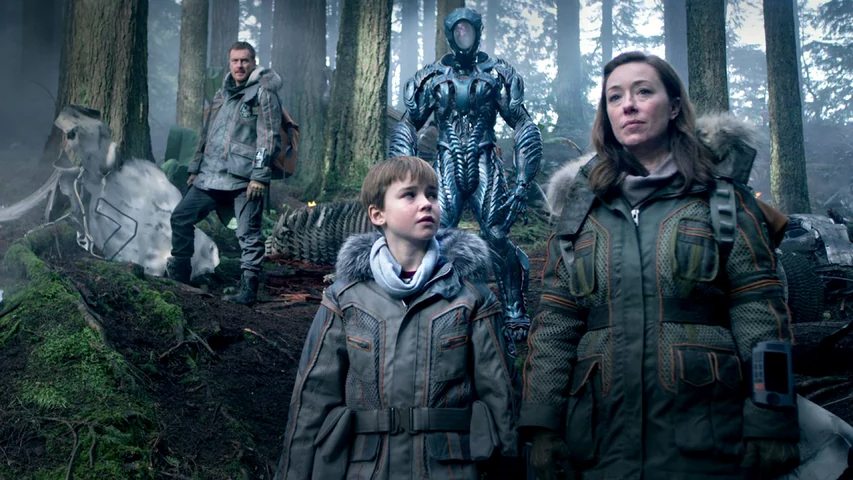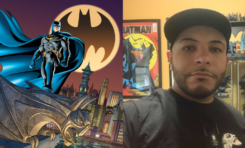In 1965, producer extraordinaire Irwin Allen (yep, the same man who all but perfected the disaster movie in the 1970s) launched Lost In Space, a sci-fi yarn about a family stranded out in the great beyond. Over 50 years later, the Robinsons have returned to the small screen.
Netflix’s all-new Lost In Space isn’t the first time that the Robinson family has been rebooted for a new generation; 1998 saw a big-screen adaptation which, despite an A-list cast, made some questionable choices storytelling-wise and was generally considered a disappointment. (Okay, that Apollo 440 remix of the theme tune wasn’t half bad, though it does feel bit dated in retrospect.) But to bring the family full circle back to television, executive producers Matt Sazama and Burk Sharpless (best known for the recent Power Rangers reboot) knew that in developing their take, they would have to shift the dynamic of this story – not only for the Robinsons but for the entire ensemble, including the iconic robot and nefarious Dr. Smith who both arrive in much different incarnations – to take this premise into the 21st century.
We had the pleasure of chatting with Matt and Burk recently to do a deep dive into some of their thought processes that went into this new incarnation of Lost In Space…
Hi guys! Tell me a little bit about both of your histories with this franchise. Was the original Lost In Space a big part of your TV experience as kids?
Sharpless: I actually did watch it regularly as a kid when it was on on syndication. I don’t remember which station, I was probably about seven or eight. I would watch it in between Mission: Impossible and Star Trek, it was part of my key diet of science fiction and action growing up. And one of the things I liked about it – I did like the robot, which made a really big impression on me – but I think what I actually most loved about it was the idea of being in a survival situation with my mom and dad. Which seemed like a really interesting, emotional place to be where you’d be challenged to survive with the people you were closest to in this really wonderful and dynamic sort of environment. [It’s] both wish-fulfillment and anxiety, if you were fighting off a monster with your father next to you on another planet. But it definitely had a big impact on me as a kid, no question.
Sazama: I did watch the show when I was a kid, but I could never figure out when shows were on so I would always stumble onto a show half-way through and I could never follow the stories. So my impression was, it was this weird dream-like imagery of a boy and a robot, and these really weird aliens and sort of foggy sound stages with these bright colors. [laughs] I could never exactly figure out what the stories were, it was sort of like a half-remembered dream of a show that really stuck with me. And it was only years later that I tracked down the show and started watching it, and realized how amazing it was. I was always struck just by the image of Will and Penny and a robot, and a creepy dude in sort of a weird, misty setting. I also remember being at the library and finding the comic book, Space Family Robinson which is how Irwin Allen was inspired to do [the show] in the first place. And those stories were equally insane, by the way. But even beyond Lost In Space, I also loved the Disney movie Swiss Family Robinson; that story which is so iconic and has been told since the 19th century has been sort of a primal thing in my life, this story of a family in a survival situation.
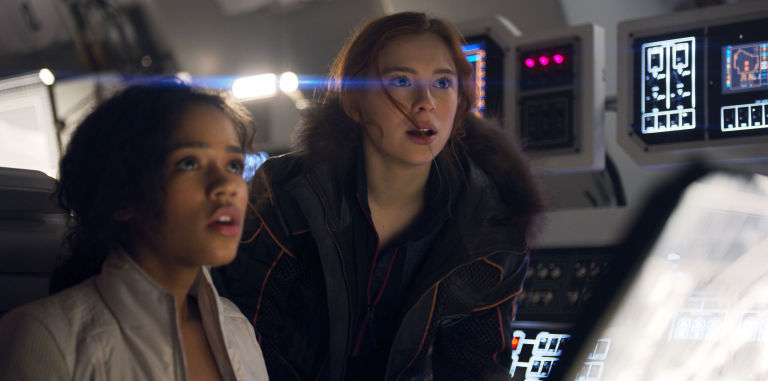
Judy (Taylor Russell) and Penny Robinson (Mina Sundwall) aboard the Jupiter 2 (Courtesy of Netflix)
In developing this premise for an different audience than the one who watched the original in the 1960s, what were some of your main objectives for updating the story?
Sazama: First and foremost, Irwin Allen created Lost in Space and we’re following in his footsteps. Our main objective was, if Irwin Allen was doing the show now in 2018, what’s the show that he would do? We have all the same elements: The characters, the robot, and Dr. Smith. But we wanted it to reflect the times that we live in. The first thing we wanted to do was make the family one that people could see themselves in, reflected back on the screen in 2018. And to take nothing away from the ‘60’s version of it, but that was a family as it was in the 60’s where you had more clear-cut gender roles, frankly, and the women even in the show were back doing laundry while the men were off having adventures. That’s not what reality is now, and it’s certainly not what reality is going to be like in thirty years when our show takes place. So it was very important to us to have Maureen Robinson, a scientist who was super-capable and used her intelligence to get herself out of problems, and certainly Judy and Penny were going to be as highly capable as Will and their dad, John.
Sharpless: Part of it is just the look and feel and texture of the show, where we have fortunately partnered with Netflix to make it and we really leaned, to the best of our ability, into a kind of cinematic texture, very high-end special effects… [plus] realism and white-knuckle excitement that you might feel if you went and saw a movie in the theater, given our background as movie screenwriters. So I think we also just wanted to update it and make it stand shoulder to shoulder with the kind of entertainment that is exciting now.
The first season dives directly into the Robinsons’ spacecraft crashing and then backs into a lot of their backstory from there. Was that always how you saw the season playing out?
Sazama: You know, in the very beginning we thought about how they might take tests and make the decision to go. And to be honest, that was not a very exciting way to start our show because really the story starts when they get lost. So once we figured out what the story was before then, we felt confident that we could just drop you into the middle of the story along with the Robinsons. Then try to replicate for the viewing audience what it might feel like to be a little disoriented, just dropped into the middle of this created situation along with Will as he jumps out of a top hatch, looks around for the first time and says “Where am I?” We kind of wanted to have that be an experience for the audience, as well. And then use flashbacks to fill in some of the story for the audience that they might be hungry for, so that it can help understand some of the character dynamics between the different characters.
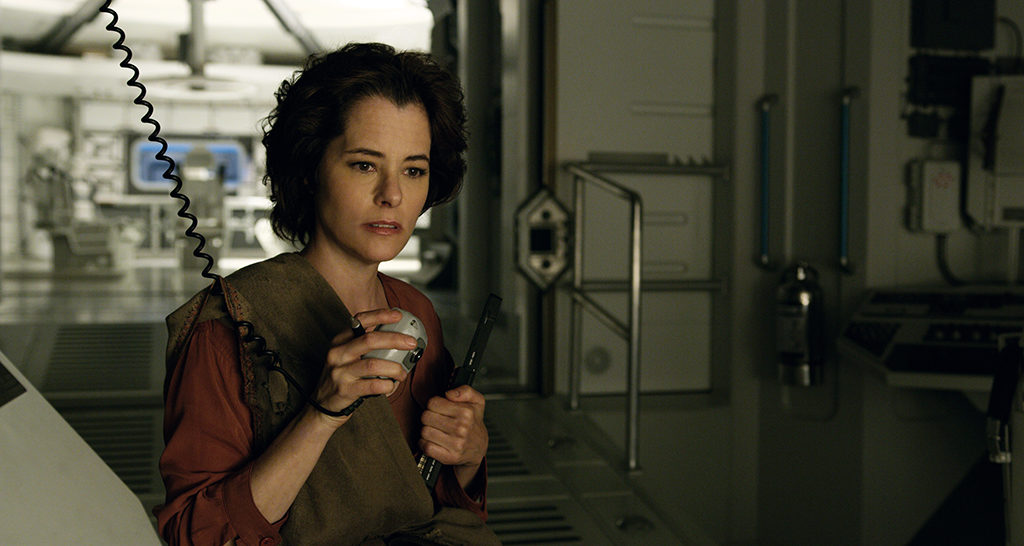
The unpredictable Dr. Smith (Parker Posey) (Courtesy of Netflix)
A lot of those flashbacks come at key moments in the main plotline, as well, and sort of dovetail into say, whatever Smith’s next move on the chess board is going to be. That also calls to mind some of the interesting diversions from the previous LiS versions, for example that Smith is a con artist posing as a doctor, or that John and Maureen’s marriage is in trouble but they’re holding it together for their kids and this mission. Where did those character shifts emerge in development?
Sharpless: I think that each one of those is sort of a different thing. Definitely with John and Maureen – partly as a writer trying to write sort of a dynamic situation, but also with the Netflix model where you know there’s going to be a long story arc for the season you sort of picture where you want people to be at the end and then backtrack so the journey to get there is catharic and emotional. Part of it is just the craft aspect of engaging with John and Maureen in a way where there was still some place for them to go. It’s funny, I’m going to say something about the show: It’s actually really optimistic and aspirational, it’s not a critique of marriage. And if you were to unravel a couple and make their world worse and worse, that would be a darker vision. Ours is a very optimistic vision of how if a family teams up and comes together to overcome a problem… you want to see that process work. You want to see them have cathartic moments and communicate and fall in love all over again. So that’s part of why, maybe, we wanted to pull people apart at the beginning… so they can come together and be strong, and we wanted to go on that journey with them.
Sazama: Also, just to add to that, we were looking for a family story from the very beginning. The characters have their own individual arcs, but for us a family story is how does John Robinson re-integrate himself into the family after a long absence, and does he succeed in doing that. That’s their story for season one, and we knew that from a very early stage. However… the Dr. Smith stuff really came out of a collaboration with all of the other writers in the writer’s room along with our showrunner Zack Estrin. Just to mention them by name, because they were all part of building the Dr. Smith character: Kari Drake, Katherine Collins, Vivian Lee, Dan McLellan and Ed McCardie. And this year, Liz Sagal is joining our writing team. To be honest, the Dr. Smith character was the least defined when Burk and I wrote the pilot because she doesn’t really appear until the very end. [She] was really a great collaboration by everyone in the Lost In Space writers room, sort of cracking who exactly she was going to be. And then of course, Parker Posey came on board and took it right over the top.
And then on a similar note of dynamic shifts but different in how, perhaps, it opens up a broader net for where the story can go: Having the Robot in this version be of alien origin instead of man-made is a unique change. Was that the intent with that aspect?
Sazama: Yeah, that was one of our first big ideas. That to us is the biggest change that we’re making with our version… and part of it came from [where] we knew the robot had to be a major character and we thought it was a great opportunity. We wanted our robot to be an actual character who had his own story and a sense of mystery about it, because the [Robinsons] story of season one is John coming back but the true story of Lost in Space is, you’ve met this alien robot and is it a friend or foe?
Sharpless: And there’s a story we wanted to tap into… that is sort of iconic, which is the young boy or girl who meets the monster or animal and tames it, and they kind of bond. You see it in The Black Stallion, you see it in The Iron Giant, you see it in Terminator 2. That, I think, really grabbed us right away and we wanted to run with that, because of course it brings up this interesting coming of age story for Will Robinson and defines the heart of the whole season. You couldn’t really do that with a robot made on Earth, but you could if you met this strange being on another planet and you bond, and that sort of shifts the course of their life all the way through the season.
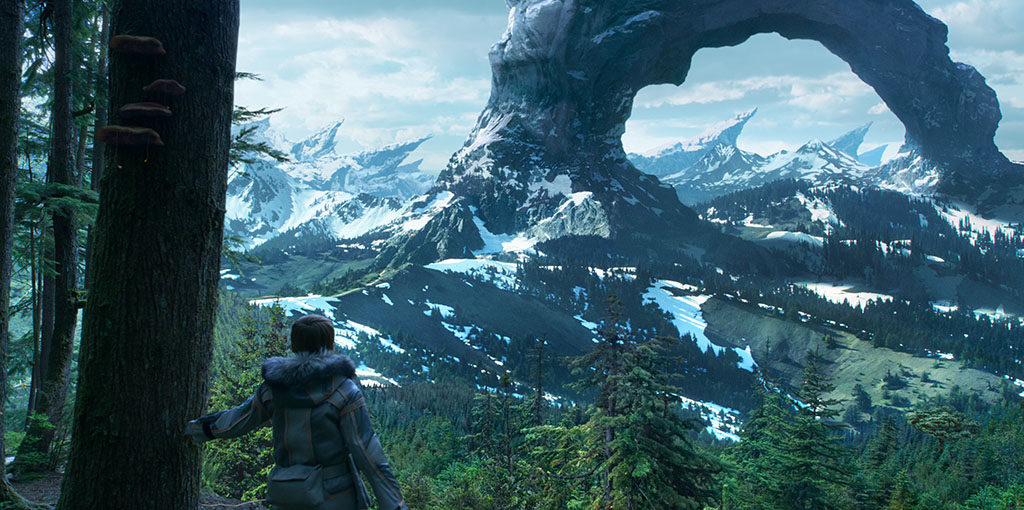
Will Robinson gazes upon an alien world. (Courtesy of Netflix)
To close: For each of you, without giving away any specific spoilers, which is your favorite episode of this first season and why?
[both laugh] Sazama: You’re making us choose between our children! Wow.
Then just say the first that comes to mind! Maybe tomorrow when you wake up it’d be different, but which is your favorite today?
Sazama: I think for me it would probably be Episode Seven… It’s one of the ones that I was on set for also, so I was there when we were building it from scratch. But it has two storylines, one is a great story of Judy Robinson being confronted and challenged with “Aren’t you just a kid? You’re just eighteen years old, can you make decisions” and her being in the position of having to make an adult decision, how does that play out? I find it to be really moving and, whether she makes the right or wrong decision or is it much more complicated is a story that I find really moving. Taylor [Russell]’s performance is really great in that one, also. And the flip side is, there’s another story between John and Maureen and it’s a really emotional culmination of what’s come in the six episodes before that. And every time I watch it I get teary-eyed, and I was teary-eyed on the set when they were filming it, and it just is two great actors giving great heartfelt performances that are about love and sacrifice and things that are important in live, and it just always gives me a feeling. And then on top of all that you’ve got a crazy Dr. Smith monologue, that is a cherry on top of the sundae, and some great scenes with Will and Penny also… in a nutshell, for me, it represents everything that we were trying to accomplish with the show.
Sharpless: I think, this might be sort of obvious but for me it’s the pilot. And in particular, the scenes where Will Robinson climbs up in the tree and connects with the robot for the first time. That was, for me – when I go to sleep at night and maybe for the rest of my life – that’s the reason that the show exists for me is that connection between Will and the robot, that story to me is the story. And [Will’s] empathy being a gift that changes this creature that was designed maybe to kill or to hurt, and maybe changing it forever and this spirit of innocence and love and bonding, it’s kind of why the show is moving. That little section is my favorite, and I’m sure it always will be.
